AM5 and subsequent X870 and B850 motherboards have been a good generation for ASRock boards. From its fair pricing to boards packed with features like its flagship X870E Taichi, there’s a lot to like. We recently covered the B850 Steel Legend and walked away from there feeling positive overall as well. Sliding one level down the company’s product stack is the B850 Livemixer ($189.99).
The brightly colored B650-based Livemixer is long gone, replaced by a more mature black and silver look. Still focused on content creators, it offers a wide range of USB connectivity “...for streaming devices and multiple other auxiliary devices.”
Below, we’ll examine the board's details and determine whether it deserves a spot on our Best Motherboards list. But before we look at test results and discuss the details, check out the specifications below, provided by ASRock.
Specifications of the ASRock B850 Livemixer Wifi
Swipe to scroll horizontally
Socket | AM5 (LGA 1718) |
Chipset | B850 |
Form Factor | ATX |
Voltage Regulator | 17 Phase (14x 80A Dr.MOS MOSFETs for Vcore) |
Video Ports | (1) HDMI (v2.1) |
| Row 5 - Cell 0 | (1) DisplayPort (v1.4) |
USB Ports | (1) USB 3.2 Gen 2 (10 Gbps) Type-C |
| Row 7 - Cell 0 | (4) USB 3.2 Gen 2 (10 Gbps) |
| Row 8 - Cell 0 | (4) USB 3.2 Gen 1 (5 Gbps) |
| Row 9 - Cell 0 | (8) USB 2.0 (480 Mbps) |
Network Jacks | (1) 2.5 GbE |
Audio Jacks | (2) Analog + SPDIF |
Legacy Ports/Jacks | ✗ |
Other Ports/Jack | ✗ |
PCIe x16 | (1) v5.0 (x16) |
| Row 15 - Cell 0 | (2) v4.0 (x4) |
PCIe x8 | ✗ |
PCIe x4 | ✗ |
PCIe x1 | ✗ |
CrossFire/SLI | ?? |
DIMM Slots | (4) DDR5-8000(OC), 256GB Capacity |
M.2 Sockets | (1) PCIe 5.0 x4 (128 Gbps) / PCIe (up to 80mm) |
| Row 22 - Cell 0 | (2) PCIe 4.0 x4 (64 Gbps) / PCIe (up to 80mm) |
SATA Ports | (4) SATA3 6 Gbps |
| Row 24 - Cell 0 | Supports RAID 0/1 |
USB Headers | (1) USB v3.2 Gen 2x2 (20 Gbps) Type-C |
| Row 26 - Cell 0 | (2) USB v3.2 Gen 2 (5 Gbps) |
| Row 27 - Cell 0 | (2) USB v2.0 (480 Mbps) |
Fan/Pump Headers | (6) 4-Pin (Accepts PWM and DC) |
RGB Headers | (3) aRGB (3-pin) |
| Row 30 - Cell 0 | (1) RGB (4-pin) |
Diagnostics Panel | (1) Post Status Checker (4 LEDs) |
Internal Button/Switch | ✗ |
SATA Controllers | ✗ |
Ethernet Controller(s) | (1) Dragon RTL8125 BG (2.5 GbE) |
Wi-Fi / Bluetooth | Realtek RZ717 Wi-Fi 7 - 320 MHz, 6 GHz, 5.8 Gbps, BT 5.4 |
USB Controllers | ASMedia ASM1074, Genesys Logic GL852 (2), Redrivers |
HD Audio Codec | Realtek ALC1220 |
DDL/DTS | ✗ / ✗ |
Warranty | 3 Years |
Inside the Box of the ASRock B850 Livemixer WiFi
You receive the bare essentials in the box: two SATA cables, a Wi-Fi antenna, and a thermistor cable. This minimal accessory package is standard for motherboards in this price range.
Design of the Livemixer
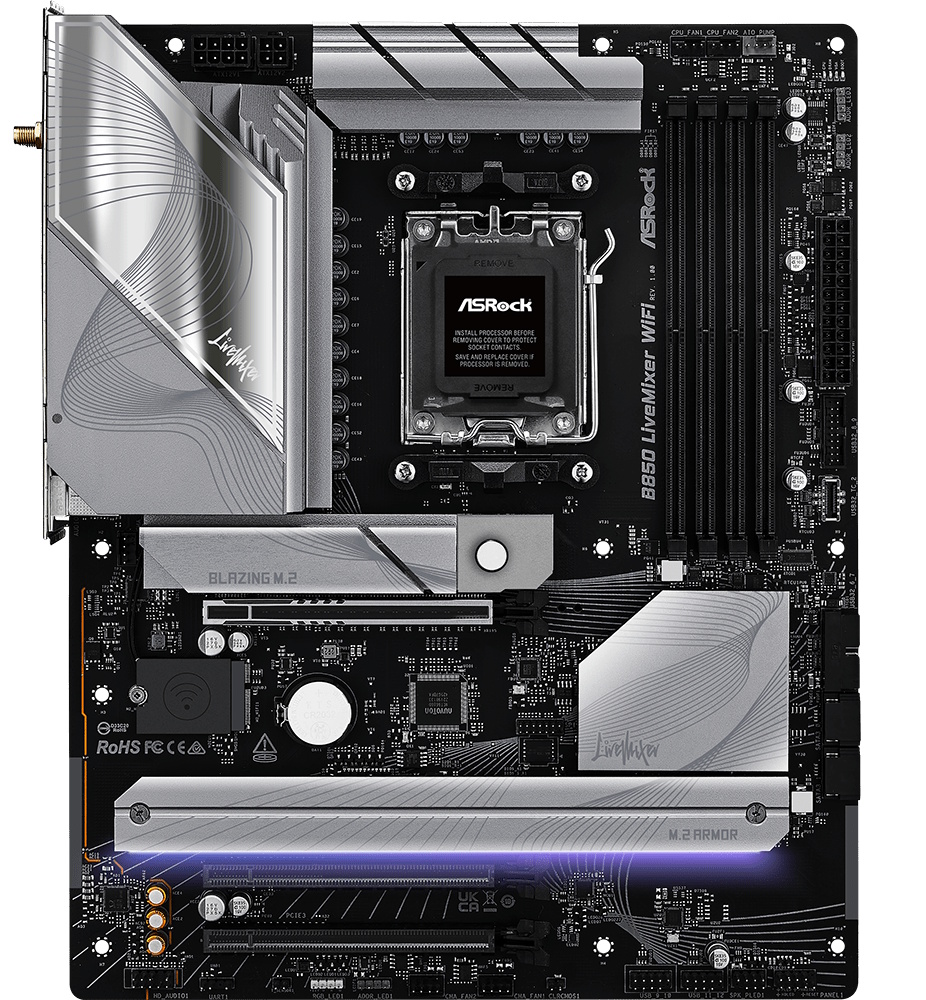
The B850 Livemixer features an 8-layer black PCB. Large silver heatsinks with a wavy-line pattern cover the VRMs, chipset, and all M.2 sockets, aesthetically integrating with the PCB. The sole RGB element, located under the extended bottom M.2 heatsink, is sufficiently bright, giving this budget-friendly motherboard an appealing and non-obtrusive appearance sure to blend in with most build themes.
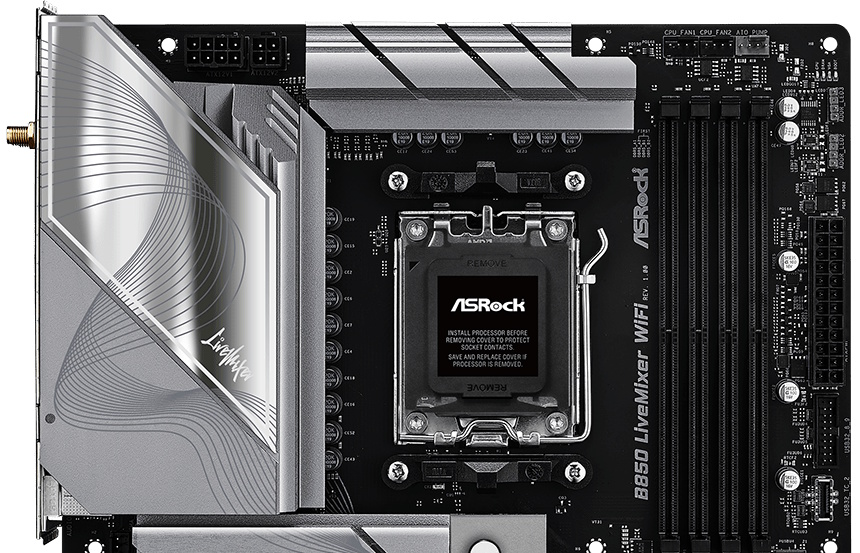
Starting in the upper left corner, we get a better look at the reflective and matte-finished VRM heatsink, featuring Livemixer branding. Between the two oversized heatsinks are an 8-pin (required) and a 4-pin EPS connector to power the processor. Nothing special here.
To the right of the socket are four unreinforced DRAM slots, with locking mechanisms on both sides. Like the Steel Legend, ASRock lists support for up to 256GB of RAM with two sticks running at speeds of up to DDR5-8000+, which is very fast for this cost-conscious chipset. Again, we experienced some issues with our Kingston DDR5-6000 kit and this BIOS, but our other, faster test kit, DDR5-7200, ran without any problems. Our best advice is to ensure your memory is on the QVL list for the best chance of compatibility.
Above the DRAM slots are the first three (of five) 4-pin fan/pump headers. Like the Steel Legend, it’s the CPU_FAN1/2 and the AIO pump. All headers work with DC- or PWM-controlled fans. The CPU_FAN1 header outputs up to 1A/12W, while the remainder outputs up to 3A/36W. CPU_FAN2, CHA_FAN1-3, and the AIO_PUMP header auto-detect whether they are connected to 3- or 4-pin devices.
Turning attention down the right edge, we first run into the Post Status Checker (PSC) LEDs, which light up during POST and remain lit if an issue occurs. Next are two 3-pin ARGB headers, followed by the 24-pin ATX connector to power the board. Last up here are the front panel 19-pin USB 3.2 Gen 1 (5 Gbps) and 3.2 Gen 2x2 Type-C (20 Gbps) headers, adding to the total on the rear.
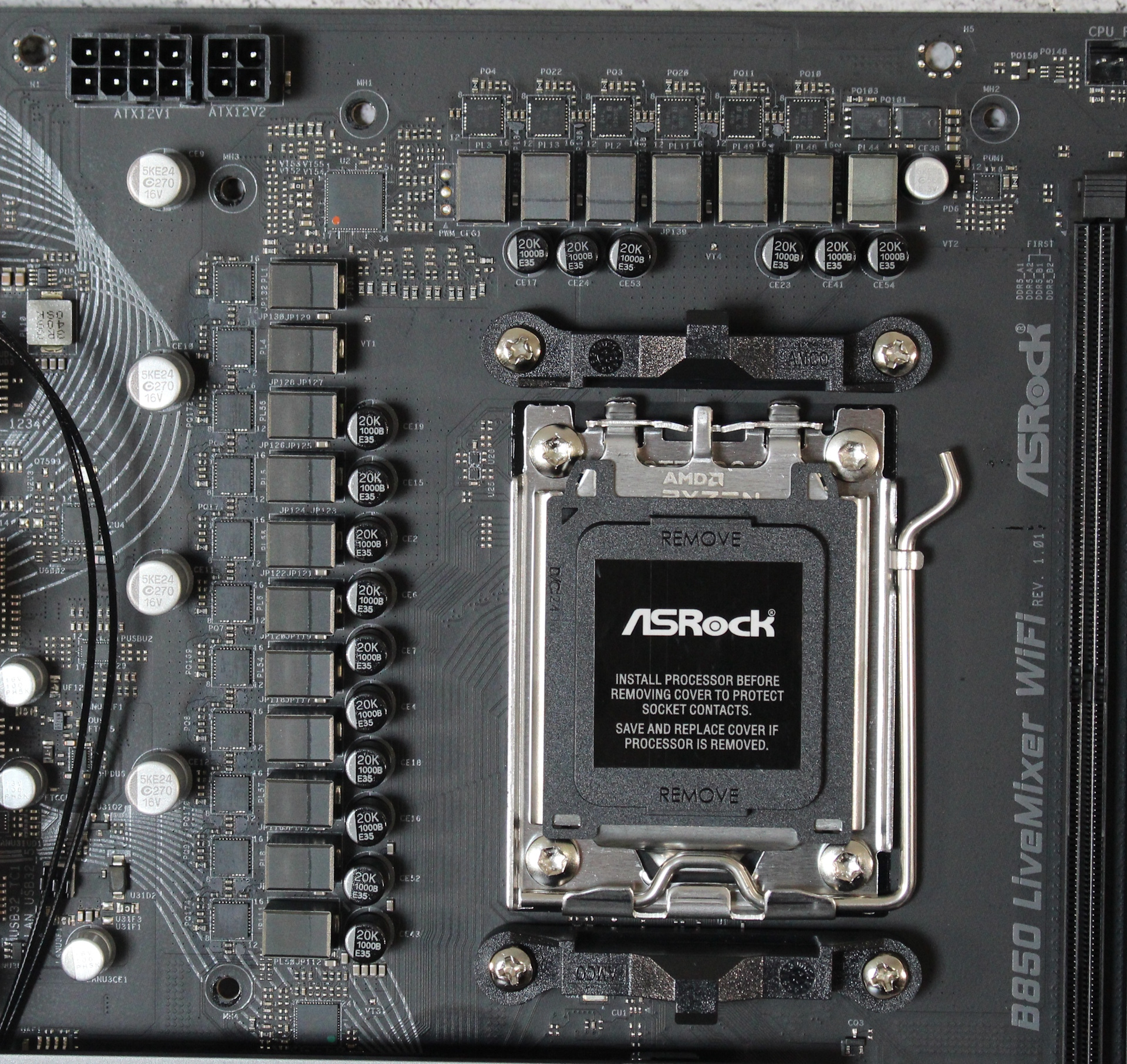
Power delivery is the same as that of the B850 Steel Legend, consisting of 17 phases, with 14 dedicated to Vcore. Power heads from the 8-pin EPS connector(s) to the Richtek RT3678BE controller (for Vcore, there’s another for the SOC/MISC). From there, it’s on to the 80A Vishay SiC659 Dr. MOS VRMs. While not the most robust, it’s still sufficient for a flagship-class processor, with cooling being the limiting factor.
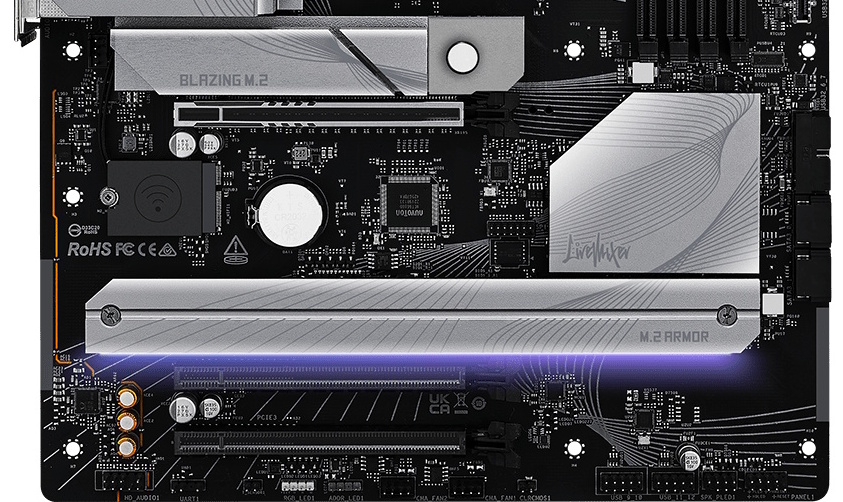
At the bottom of the board, starting from the left, we can easily see the last-generation flagship Realtek ALC1220 audio chip. Flanking it are three dedicated audio capacitors and the audio separation line. It’s not the latest and greatest audio solution, but for the price, it’s a solid option. If it’s not good enough, there are enough PCIe slots to add a PCIe-based sound card.
Speaking of PCIe, the Livemixer offers three full-length slots, with the top slot reinforced for added stability. The top is the primary slot for graphics, connecting through the CPU, and supports up to PCIe 5.0 x16. The bottom two slots are connected via the chipset and operate at PCIe 4.0 x4 (M.2 supports RAID 0/1/10). The bottom slot, PCIe_3, does share lanes with an M.2 socket (M.2_3), so it’s one or the other.
Just above the PCIe slot is the large M.2 heatsink, featuring a DIY-friendly one-push latching mechanism. The socket supports up to PCIe 5.0 x4 (128 Gbps) and accommodates devices up to 80mm in length. The bottom two slots also support up to 80mm modules, but are the ‘slower’ PCIe 4.0 x4 (64 Gbps) speeds. Again, M.2_3 shares bandwidth with PCIE_3, so be aware if you need to use that bottom PCIe slot and a third M.2.
Past the chipset and along the right edge is another 19-pin USB 3.2 Gen 1 connector, and below that, four SATA ports (support RAID 0/1).
Across the bottom are several useful headers. From left to right, you get:
- Front Panel audio
- 3-pin UART
- 2-pin Thermistor header
- 4-pin RGB, 3-pin ARGB
- (2) 4-pin Chassis Fan headers
- 2-pin Clear CMOS jumper
- (2) USB 2.0 headers
- Front Panel

The rearIO is laid out logically and labeled clearly, which makes things easy (if you can see behind your chassis). On the left is the HDMI video output for integrated graphics, and next to that are the standard Wi-Fi 7 antenna connections. A small BIOS Flashback button is next, followed by two stacks of four USB ports. On the left are four USB 2.0 ports, with two additional ports located on top. The USB 3.2 Gen 1 (5 Gbps) Lightning Gaming ports (on their own controller, free from other USB traffic) at the bottom, indicted by the orange ports. Next to these are the two 10 Gbps Type-C ports and another 5 Gbps Type-A port, both in light blue. Last but not least is the Realtek 2.5 GbE and audio stack, featuring two 3.5mm (mic in/line out) ports and an SPDIF port.
MORE: Best Motherboards
MORE: How To Choose A Motherboard
MORE: All Motherboard Content

 3 months ago
53
3 months ago
53
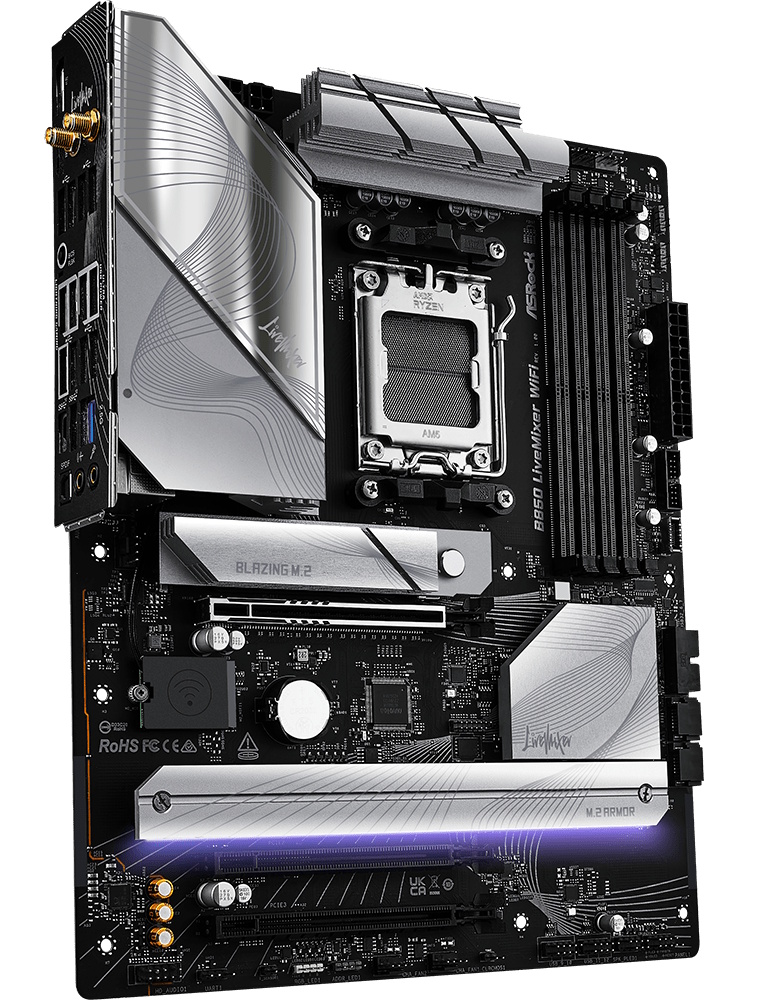
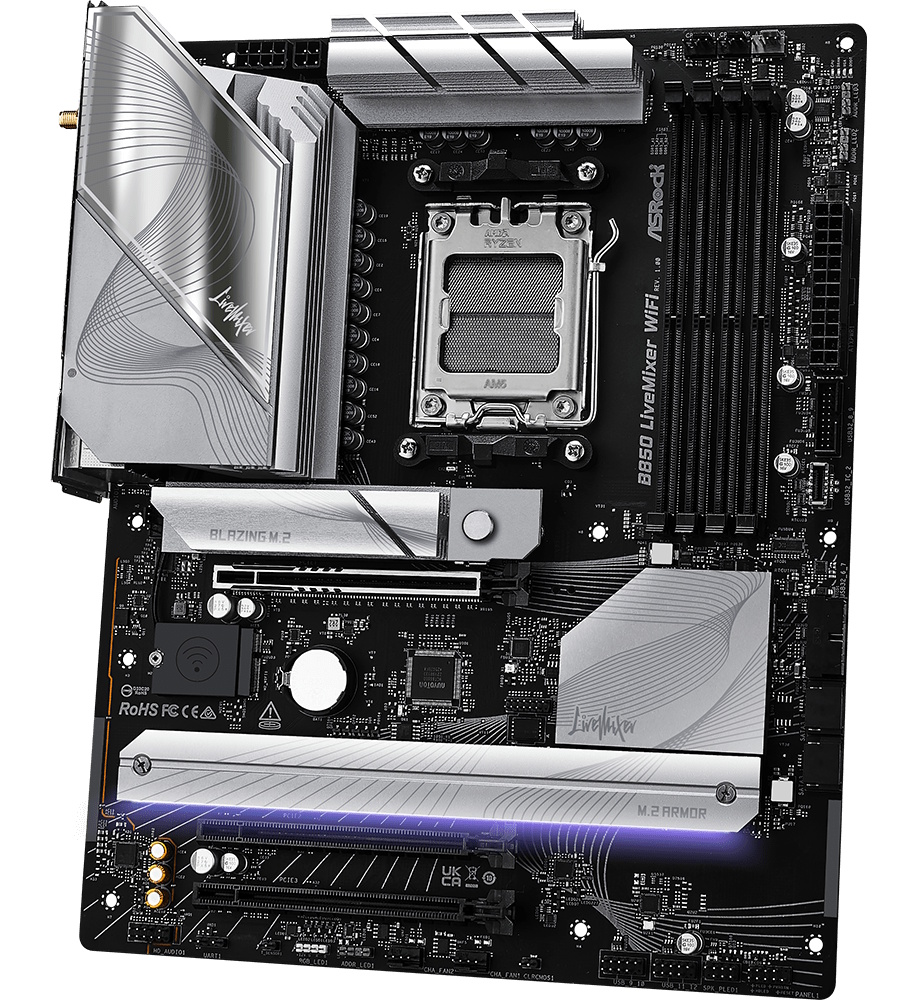

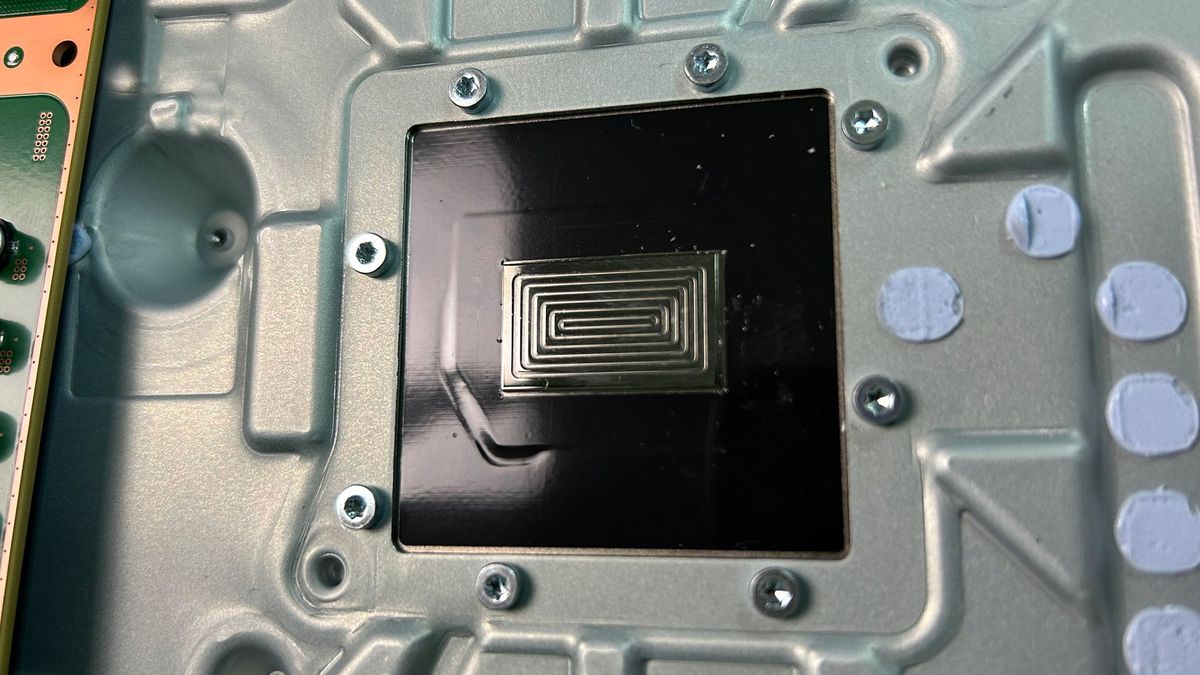
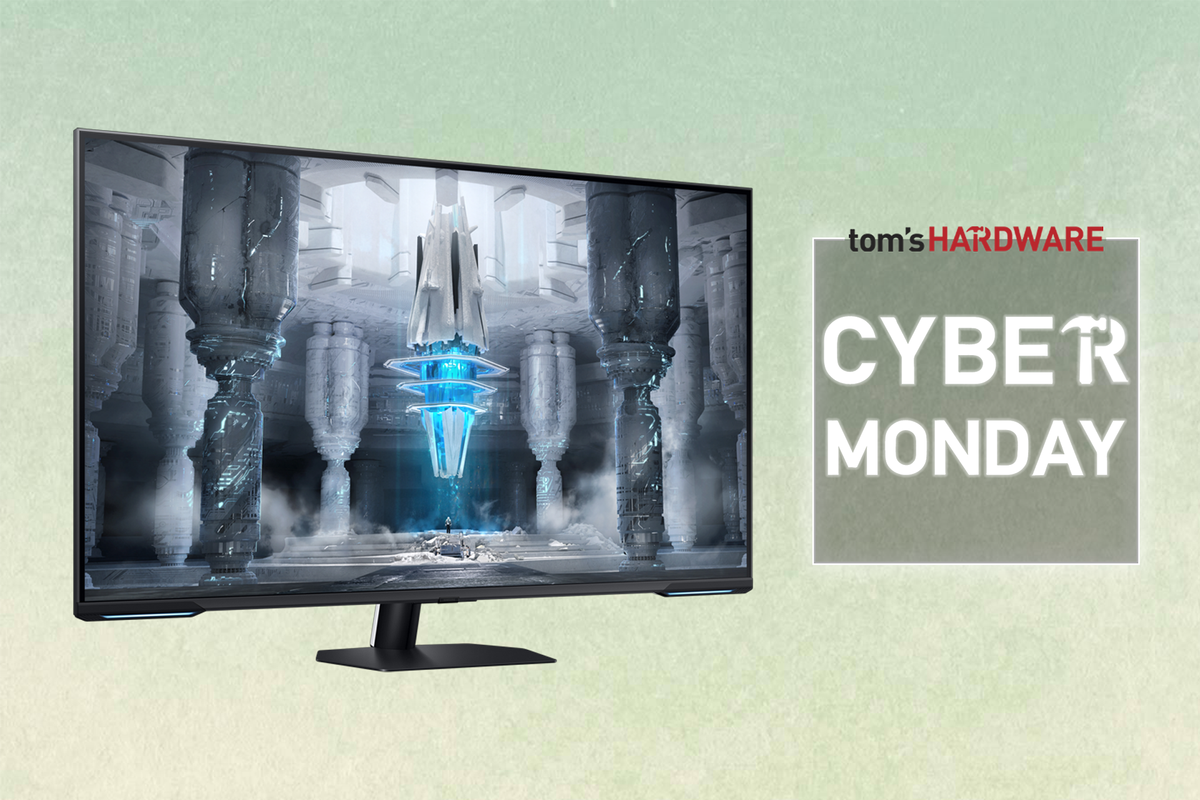
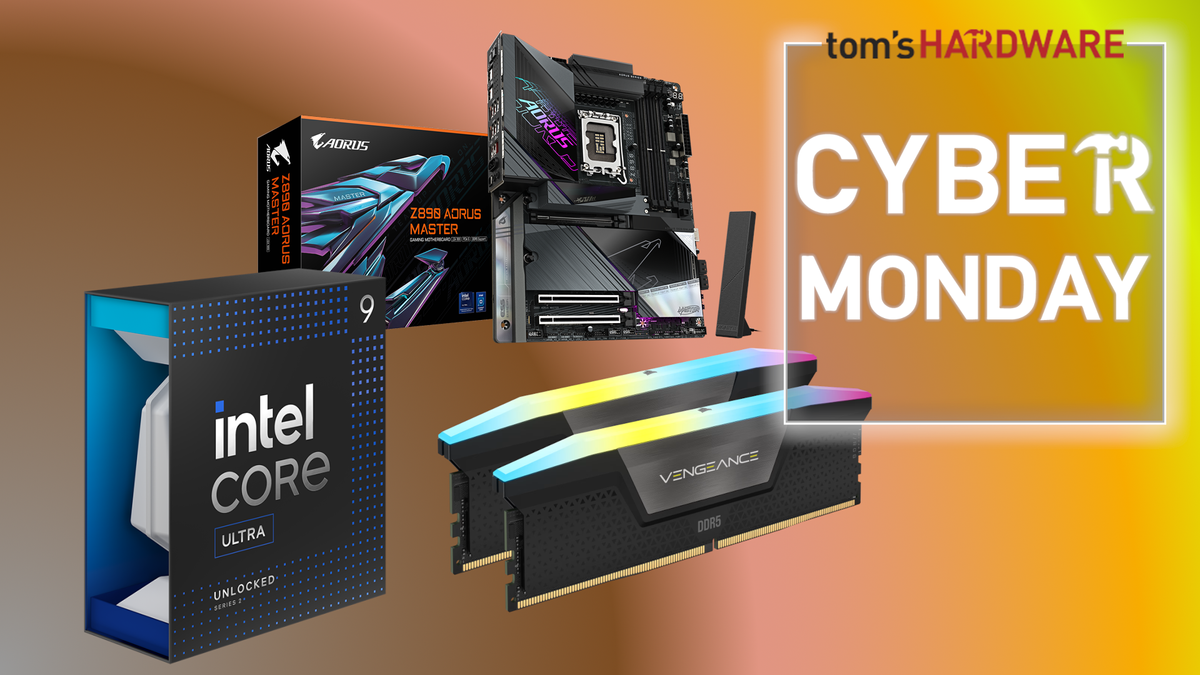


 English (US) ·
English (US) ·